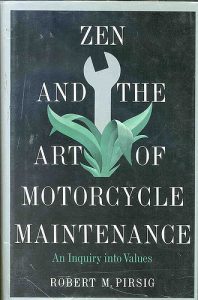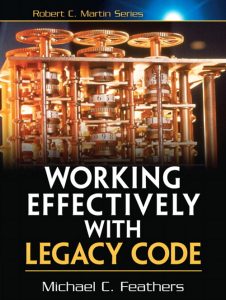This post combines a few ideas from the following books:
Zen and the Art of Motorcycle Maintenance – Disregard the title, this book is about the philosophy of value and quality. I enjoyed reading the meandering tale of a man on a motorcycle tour thinking about what it means to do things well. You will need chapter 25, things which shake your quality focus during a maintenance task.
Working Effectively with Legacy Code – This is a practitioners guide to coping with a problem we have all created for ourselves at some point or other. For me this period was about the first 10 years of my career. Legacy code is code without tests, almost always accompanied by having no documentation. This code has merrily chugged along, doing what it does since its birth but now you must add a new feature or fix a bug. We have all had a system with 9 bugs, where you fix one, and now you have 12 bugs.
Clean Code – I read this book at the tail end of last year and it completely changed the way I programmed. If you only read one book about programming read this. It also gave me an excellent gauge for what Pirsig describes as classical quality. There are a lot things I intuited were good but did not know why and this book made those things explicit. The important message for this post is “The boy scout rule”; always leave the camp site cleaner than you found it.
Combining the lessons from these books has helped me take a beastly code base and make it elegant. Begin by getting your “Zen” right, this is not a smash and grab you are going to turn this mess into a quality product. The gumption (quality focus) traps to avoid include:
- Wishing you started from scratch – Don’t spend your maintenance time wishing you had re-written the code from
 the ground up. The grass always looks greener in that empty document root but trust me it is not. If this was so easy to do from scratch how did you make such a hash of it the first time? The problems of your current code are hard, start-over code will have hard problems too but they are further away. You felt as positive when you started this code base as you do about starting over. You will feel just as bad again, the fact is good software is hard to write.
the ground up. The grass always looks greener in that empty document root but trust me it is not. If this was so easy to do from scratch how did you make such a hash of it the first time? The problems of your current code are hard, start-over code will have hard problems too but they are further away. You felt as positive when you started this code base as you do about starting over. You will feel just as bad again, the fact is good software is hard to write. - Thinking you don’t need tests – You need tests. Yet you would be a fool not to have a good click around your in your application after you make a proper change. Clicking around your software is slow and inconsistent. Even with a testing team you wont click the full set of possibilities. Write tests for the existing code before you refactor and you will be sure you won’t introduce bugs.
- Fear of big changes – It is surprising how you stop worrying about making changes when you have tests. It is reassuring to know you aren’t breaking things.
- The big rush – This code base is hard to change, it makes everything slow, writing tests is even more time consuming. Writing it from scratch will be slower and once you have written a few tests you will get the rhythm. As you test more the speed you can make changes will start to improve until you can actually go quite fast. What’s the hurry though? You are trying to build something quality, you shouldn’t rush quality. Also you have the perfect excuse for going slow “sorry this code is old and hard to work on”. You wont have the excuse if you start from scratch.
 The trick of working with legacy code is to determine suitable chunks to test. From my experience adding a full set of unit tests to a legacy code base of any size is almost impossible so do not try. User interface tests like Selenium can be good but it is hard to get good coverage with them. They are slow to write, slow to run and they can be quite brittle. Have a light covering of these tests over a broad set of features to avoid embarrassing bungles.
The trick of working with legacy code is to determine suitable chunks to test. From my experience adding a full set of unit tests to a legacy code base of any size is almost impossible so do not try. User interface tests like Selenium can be good but it is hard to get good coverage with them. They are slow to write, slow to run and they can be quite brittle. Have a light covering of these tests over a broad set of features to avoid embarrassing bungles.
The real name of the game here is integration tests. If your code wasn’t written with unit tests it is certain to be un-unit-testable; there will be tight coupling all over the shop. Use integration tests to test natural lumps of functionality. You are likely to need a database of test data. Your integration tests will soon end up taking tens of seconds to run so your tool chain must let you run a sub set of tests. This will let you iterate on the particular area of the code you are testing. Once you have a nasty lump of code under test you can start refactoring the components and add better tests as you go. After not so long the lump of code will be a set of quite well encapsulated classes with unit tests. If you repeat this pattern for every lump of code in the project you will have a quality code base.
The hardest test to write is the first. It’s psychologically hard because it is change of mindset. It is a big learning curve because you will have to work out how to get the test framework into the existing project. It will being boring because you need to create a bunch of test data. It is a technical challenge because you have to work out what the existing code does to test it. In spite of all that you have to do it. It is the only way you will ever achieve quality and if you read this far it’s because you want to deliver quality.
So how now you have a code cleaning approach how do you choose what to clean? The boy scout rule! The whole code base is a mess so  start with the bit where you want to add your feature. To add the feature you will have to learn how the surrounding code works. You can specify that knowledge in tests. You add some integration tests and then clean the camp site for a while. Once you are happy that it is clean enough to work with you can add your new feature and it’s associated unit tests. Now you have a clean place to put it your new code can have proper unit tests.
start with the bit where you want to add your feature. To add the feature you will have to learn how the surrounding code works. You can specify that knowledge in tests. You add some integration tests and then clean the camp site for a while. Once you are happy that it is clean enough to work with you can add your new feature and it’s associated unit tests. Now you have a clean place to put it your new code can have proper unit tests.
It will take a long time to get your code base clean using this method. Adding a new features will give you good test coverage and make the code easier to work with. You will have well defined methods with good naming and simple logic. You might choose to spend your Friday afternoon doing a bit of camp site cleaning before you clock off. Remember there is no rush. There are always new features to add so you will have plenty of opportunities to clean.
Remember well written tests specify what the code should do. If another programmer wants to change your code they should read your tests. If they change the code’s behaviour a test will tell them the impact of that change.


0 Responses
Stay in touch with the conversation, subscribe to the RSS feed for comments on this post.